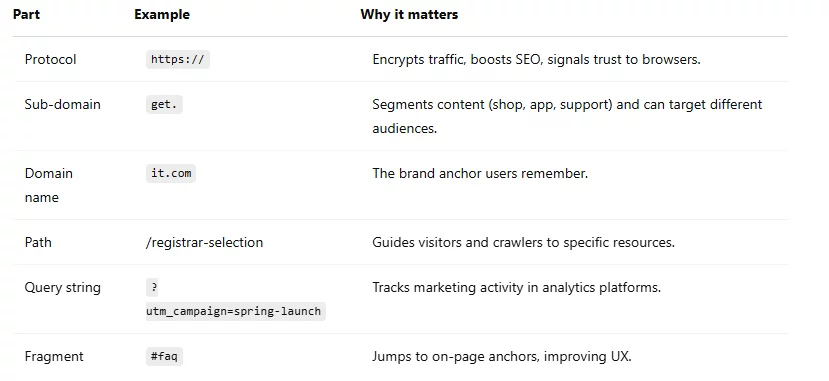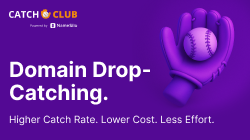- Joined
- Oct 12, 2023
- Posts
- 122
- Reaction score
- 47
Every visit to your website starts with a web address, but that address is actually two distinct pieces doing two very different jobs. Grasping the difference between the domain name and URLs is business critical – let’s unpack how the pair work together, why that matters for growth, and how to use each one to sharpen your marketing edge.
In the early 1980s, the web was little more than scattered islands of research servers. Every machine was reached by typing an IP address – a four‑part string of numbers such as 192.0.2.146. Memorising those addresses was about as fun as trying to remember every phone number in your contact list.
Enter the Domain Name System (DNS), introduced in 1983 to translate numeric IPs into words people could remember. By 1985 symbolics.com was registered as the first commercial domain, and the rest is very clickable history.
Today more than 360 million domains are live. Each one brings a complex routing process down to a handful of characters your customers can type or say.
Your domain is a sign over your shop door, a concise label you register and promote everywhere your brand appears. It’s the memorable address that points browsers to your server and to everything hosted there – site, email, sub‑domains. Technically a domain name is just a label mapped to an IP address in the DNS.
When brightideas.it.com rolls off a customer’s tongue, they’re unlikely to realise a silent lookup is converting that phrase into a number a computer can route. That’s the beauty of domain names: complexity hidden behind simplicity.

Source: get.it.com
If a domain is the shop sign, a URL is the full set of directions to a product on a specific shelf. A Uniform Resource Locator strings together multiple components -protocol, sub‑domain, domain, path, parameters, fragment – to tell browsers exactly where to land.
Let’s take a look at .
Add ?ref=email and you’ve attached UTM parameters for your analytics dashboard; tack on #pricing and you’re jumping to an on‑page section of a content.
URLs can look intimidating, yet each piece has a logical job. Under the hood, a browser dissects each of these parts. To your visitor, a well‑structured URL simply feels clear, professional, and trustworthy.

Key parts of a well-structured URL
First and foremost, let’s leave behind some myths surrounding both domains and URLs.
“Buying the domain automatically manages my URLs structure.”
Afraid not. Your content management system (CMS) may still churn out weird slugs – edit them before you press publish.
“Sub‑domains are not great for SEO.”
Google treats sub‑domains as separate sites, so there is nothing preventing from building a great search presence of a subdomain.
“Shorten every link for social.”
Link shorteners are great for tracking, but we recommend revealing the real domain on landing pages to reinforce trust.
And here’s why you should care about your domain and URL structures:

Source: Unsplash
When selecting a domain name for your business, and then managing the URL creation for your business’ website, adhere to a few simple rules to make both work harder.
Selecting a domain feels like naming a band: exciting but nerve‑racking. Start with something you can say aloud without having to repeat or explain it. Under 15 characters is a helpful rule of thumb, yet clarity trumps brevity. Once you’ve found the perfect name:
To sum up, a domain is your home, a URL is the full address to any room inside. Nail the domain first, refine URLs as you grow, and keep structures consistent. Do that and the “house” you’re building online becomes easier for customers – and search engines – to find.
Keen to turn digital addresses into business growth engines? Visit it.com Domains for expert tips and user-friendly domain solutions.
Continue reading at the it.com Domains blog...
From numbers to names
In the early 1980s, the web was little more than scattered islands of research servers. Every machine was reached by typing an IP address – a four‑part string of numbers such as 192.0.2.146. Memorising those addresses was about as fun as trying to remember every phone number in your contact list.
Enter the Domain Name System (DNS), introduced in 1983 to translate numeric IPs into words people could remember. By 1985 symbolics.com was registered as the first commercial domain, and the rest is very clickable history.
Today more than 360 million domains are live. Each one brings a complex routing process down to a handful of characters your customers can type or say.
What is a domain name?
Your domain is a sign over your shop door, a concise label you register and promote everywhere your brand appears. It’s the memorable address that points browsers to your server and to everything hosted there – site, email, sub‑domains. Technically a domain name is just a label mapped to an IP address in the DNS.
When brightideas.it.com rolls off a customer’s tongue, they’re unlikely to realise a silent lookup is converting that phrase into a number a computer can route. That’s the beauty of domain names: complexity hidden behind simplicity.

Source: get.it.com
What is a URL?
If a domain is the shop sign, a URL is the full set of directions to a product on a specific shelf. A Uniform Resource Locator strings together multiple components -protocol, sub‑domain, domain, path, parameters, fragment – to tell browsers exactly where to land.
Let’s take a look at .
- The https:// protocol secures the connection,
- blog. is the sub‑domain carving out a specific section of content,
- it.com is the domain,
- /startup-guide is the path to a single article.
Add ?ref=email and you’ve attached UTM parameters for your analytics dashboard; tack on #pricing and you’re jumping to an on‑page section of a content.
URLs can look intimidating, yet each piece has a logical job. Under the hood, a browser dissects each of these parts. To your visitor, a well‑structured URL simply feels clear, professional, and trustworthy.

Key parts of a well-structured URL
Why domains and URLs matter for business
First and foremost, let’s leave behind some myths surrounding both domains and URLs.
“Buying the domain automatically manages my URLs structure.”
Afraid not. Your content management system (CMS) may still churn out weird slugs – edit them before you press publish.
“Sub‑domains are not great for SEO.”
Google treats sub‑domains as separate sites, so there is nothing preventing from building a great search presence of a subdomain.
“Shorten every link for social.”
Link shorteners are great for tracking, but we recommend revealing the real domain on landing pages to reinforce trust.
And here’s why you should care about your domain and URL structures:
- Brand recall. People type domains, not IP addresses. Short, descriptive names build authority and are easier to share on podcasts or at conferences.
- Search performance. Search engines read both the domain and the URL slug. Clean, meaningful URLs improve click‑through rates and help crawlers understand relevance faster.
- Security & compliance. Trick URLs and look‑alike domains are a fraudster’s playground. Enforcing HTTPS (a secure hypertext transport protocol) and a consistent, predictable structure protects data and reduces phishing risk.
- Accurate analytics. UTM (Urchin Tracking Module) parameters added to a URL to track the performance of online marketing campaigns, which are tucked into URL feed tools like Google Analytics, giving you the data to double down on campaigns that really work.

Source: Unsplash
Best practices
When selecting a domain name for your business, and then managing the URL creation for your business’ website, adhere to a few simple rules to make both work harder.
Selecting a domain feels like naming a band: exciting but nerve‑racking. Start with something you can say aloud without having to repeat or explain it. Under 15 characters is a helpful rule of thumb, yet clarity trumps brevity. Once you’ve found the perfect name:
- Lock it in early. Domains sell fast and aftermarket prices can sting.
- Guard the edges. Register common misspellings and regional variants. If you’re scaling internationally, think about securing .com, .co.uk, .de, or a memorable third‑level like .it.com.
- Turn on auto‑renew. No founder wants a renewal email buried in spam to take the site offline.
- Enable two‑factor authentication. Hijacked domain accounts are surprisingly common and can cripple a launch.
When it comes to URL hygiene, keep them user‑ and SEO‑friendly
- Default to HTTPS. Most modern browsers now flag HTTP pages as “not secure”.
- Use hyphens for spaces – search engines read them as word dividers.
- Lead with the keyword. yourbrand.it.com/pricing beats yourbrand.it.com/page‑id‑123 for clarity (and ranking).
- Avoid endless nesting. /blog/2025/04/17/how‑to‑price‑saas/startup/guide/part‑3 looks messy; aim for two or three levels deep.
- Redirect intelligently. If you must change a live URL, set a 301 redirect so users and link juice follow.
To sum up, a domain is your home, a URL is the full address to any room inside. Nail the domain first, refine URLs as you grow, and keep structures consistent. Do that and the “house” you’re building online becomes easier for customers – and search engines – to find.
Keen to turn digital addresses into business growth engines? Visit it.com Domains for expert tips and user-friendly domain solutions.
Continue reading at the it.com Domains blog...



















